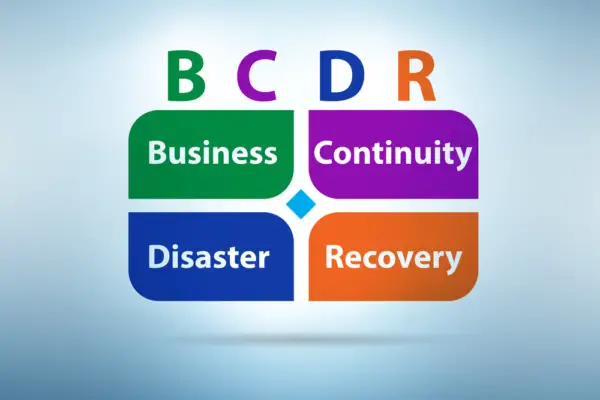Business continuity planning is crucial to any organization’s risk management strategy. A business continuity plan (BCP) outlines the procedures and protocols that a company must follow to ensure that essential business functions can continue during and after a disaster or disruption.
It is a proactive approach that can help minimize the impact of unexpected events and protect the company’s reputation, assets, and personnel.
The need for a business continuity plan cannot be overstated. Disruptions can come in various forms, such as natural disasters, cyber-attacks, power outages, or even pandemics.
Companies may struggle to respond to such events without a BCP, leading to prolonged downtime, lost revenue, and reputational damage.

A well-designed business continuity plan can help companies mitigate these risks and ensure they can continue operating during and after a disruption.
Key Takeaways
- Business continuity planning is a proactive approach that helps companies minimize the impact of unexpected events and protect their assets, reputation, and personnel.
- Disruptions can come in various forms, and a business continuity plan is necessary to ensure that essential business functions can continue during and after a disaster or disruption.
- A well-designed business continuity plan can help companies mitigate risks, ensure continuity of operations, and minimize downtime, lost revenue, and reputational damage.
Understanding Business Continuity Planning
Definition and Importance
Business Continuity Planning (BCP) is the process of creating a proactive strategy to ensure an organization’s critical functions and operations can continue in the face of unforeseen disruptions. Simply put, it is a plan that ensures the continued operation of a business in the event of a disaster or disruption.
The importance of BCP cannot be overstated. It helps businesses to prepare for the worst-case scenario, which can include natural disasters, cyber-attacks, power outages, and other unforeseen events. By having a BCP in place, businesses can minimize the impact of these events, protect their reputation, and ensure the safety of their employees.
Key Components
The key components of a BCP include:
- Risk Assessment involves identifying potential risks and evaluating their impact on the business. A risk assessment helps businesses to prioritize their response efforts and allocate resources accordingly.
- Business Impact Analysis: This involves analyzing the potential impact of a disruption on the business. It helps businesses identify critical functions and processes and prioritize recovery efforts.
- Recovery Strategies: This involves developing strategies to recover critical functions and processes. Recovery strategies include backup systems, redundant infrastructure, and alternative work locations.
- Plan Development and Testing: This involves developing a detailed plan for responding to disruption and testing it to ensure its effectiveness. Testing helps businesses to identify weaknesses in their plan and make necessary improvements.
- Training and Awareness: This involves training employees on the BCP and raising awareness of its importance. This ensures that employees are prepared to respond to disruption and can help to minimize its impact.
BCP is a critical component of any business’s risk management strategy. By having a BCP in place, businesses can ensure the continued operation of their critical functions and processes in the event of a disruption.
Risk Assessment and Analysis
A crucial part of creating a business continuity plan is conducting a thorough risk assessment. This involves identifying and analyzing potential risks that could disrupt critical business functions. By doing so, organizations can prioritize mitigation efforts and establish a more effective plan to ensure their resilience.
Conducting Business Impact Analysis
One important aspect of risk assessment is conducting a business impact analysis (BIA). This involves identifying critical business functions and determining the potential impact of disruptions to those functions.
In understanding the potential consequences of disruptions, organizations can better prioritize their response efforts and allocate resources accordingly.
During a BIA, organizations should consider factors such as the financial impact of disruptions, the impact on customer service, and the potential legal and regulatory consequences of disruptions. By taking a comprehensive approach to the BIA, organizations can ensure that their business continuity plan addresses all potential impacts of disruptions.
Identifying Potential Risks
Another critical aspect of risk assessment is identifying potential risks. This involves analyzing internal and external factors that could disrupt critical business functions.
Internal factors could include equipment failure, power outages, and human error, while external factors could include natural disasters, cyber attacks, and supply chain disruptions.
By identifying potential risks, organizations can take proactive steps to mitigate those risks and ensure their resilience. This could include implementing redundancies in critical systems, establishing backup power sources, and developing contingency plans for supply chain disruptions.
In conclusion, conducting a thorough risk assessment is a critical component of creating an effective business continuity plan. By conducting a BIA and identifying potential risks, organizations can prioritize their response efforts and allocate resources effectively to ensure their resilience in the face of disruptions.
Developing the Continuity Plan
Developing a business continuity plan involves several key strategies and procedures that organizations should follow to ensure the plan’s effectiveness.
These strategies and procedures include identifying critical functions, establishing recovery objectives, and defining procedures for executing the recovery plan.

Key Strategies and Procedures
To develop a successful continuity plan, organizations should follow these key strategies and procedures:
- Identify critical functions: Organizations should identify and prioritize their critical functions based on their importance to the organization’s survival. This step helps organizations focus on the most important functions during a disruption.
- Establish recovery objectives: Recovery objectives include recovery point (RPO) and recovery time objectives (RTO). The RPO is the maximum amount of data loss an organization can tolerate. At the same time, the RTO is the maximum amount of time it can take to recover critical functions after a disruption. Organizations should establish RPOs and RTOs that align with their critical functions and business needs.
- Define procedures for executing the recovery plan: Organizations should define procedures for executing the recovery plan, including roles and responsibilities, communication protocols, and testing procedures. These procedures should be documented and regularly reviewed to ensure their effectiveness.
Establishing Recovery Objectives
Establishing recovery objectives is a critical step in developing a continuity plan. Recovery objectives help organizations determine the amount of resources needed to recover critical functions after a disruption. Organizations should consider the following when establishing recovery objectives:
- Recovery point objective (RPO): The RPO is the maximum amount of data loss an organization can tolerate. Organizations should establish RPOs that align with their critical functions and business needs. For example, if an organization’s critical function is processing financial transactions, it may need an RPO of zero, meaning it cannot tolerate any data loss.
- Recovery time objective (RTO): The RTO is the maximum amount of time it can take to recover critical functions after a disruption. Organizations should establish RTOs that align with their critical functions and business needs. For example, if an organization’s critical function is processing financial transactions, it may need an RTO of two hours, meaning it cannot afford to be offline for more than two hours.
Developing a continuity plan involves several key strategies and procedures that organizations should follow to ensure the plan’s effectiveness.
These strategies and procedures include identifying critical functions, establishing recovery objectives, and defining procedures for executing the recovery plan. By following these steps, organizations can ensure that they are prepared to recover from disruptions and continue their critical functions.
Preparation and Prevention
Business Continuity Planning (BCP) is a process that helps businesses prepare for and recover from potential threats to their organization. The BCP ensures that personnel and assets are protected and able to function in the event of a disaster. The process involves several aspects, including training, infrastructure, prevention, and equipment.
Training and Awareness
One of the critical aspects of the BCP is training and awareness. Employees need to be trained on the importance of the BCP and how to implement it.
The training should cover topics such as emergency response procedures, evacuation plans, and data backup and recovery. Regular drills and exercises should be conducted to ensure that employees are familiar with the procedures and can respond effectively in case of an emergency.
Infrastructure and Equipment
Another critical aspect of the BCP is infrastructure and equipment. Businesses need to have the necessary infrastructure and equipment to support their operations during an emergency.
This includes backup power, communication systems, and IT infrastructure. The infrastructure and equipment should be regularly tested and maintained to ensure that they are in good working condition.
Prevention is also an essential aspect of the BCP. Businesses need to identify potential threats and take steps to prevent them from occurring.
This includes implementing security measures such as access controls, fire suppression systems, and intrusion detection systems. Regular risk assessments should be conducted to identify potential threats and vulnerabilities.
Businesses need to prepare and prevent potential threats to their organization by implementing a BCP. The BCP involves several aspects, including training, infrastructure, prevention, and equipment. By taking these steps, businesses can ensure that they are prepared to respond effectively in case of an emergency.
Response to Disruptions
When a crisis or disaster strikes, having a business continuity plan in place can mean the difference between a company’s survival or failure. The ability to respond quickly and effectively to a disruption can minimize the impact and help a company recover faster.
Crisis Management and Response
One of the key components of a business continuity plan is crisis management and response. This involves identifying potential crises or disasters that could occur, and developing a plan of action to respond to them.
The plan should include a clear chain of command, with designated individuals responsible for making decisions and communicating with stakeholders.
In addition, the plan should outline specific procedures for responding to different types of disruptions. For example, a company may have different procedures for responding to a natural disaster versus a cyber attack. The plan should also include protocols for evacuating employees and securing company assets.
Communication and Collaboration
Effective communication and collaboration are essential during a crisis or disaster. A business continuity plan should include procedures for communicating with employees, customers, suppliers, and other stakeholders.
This may involve establishing an emergency communication system, such as a phone tree or messaging platform, to quickly disseminate information.
In addition, the plan should outline procedures for collaborating with external partners, such as government agencies or other businesses. This may involve sharing resources or expertise to help mitigate the impact of the disruption.
Overall, a business continuity plan is a critical component of any organization’s risk management strategy. By developing a plan that includes crisis management and response, communication, and collaboration, companies can minimize the impact of disruptions and ensure their continued success.
Recovery and Restoration
When an unexpected event occurs, it is critical to have a plan in place to recover and restore operations as quickly as possible. This is where a business continuity plan comes into play.
By implementing recovery plans and restoring operations, businesses can minimize the impact of the event and get back to normal business operations as soon as possible.
Implementing Recovery Plans
Recovery plans are an essential component of any business continuity plan. These plans outline the steps that need to be taken to recover critical business processes and systems in the event of a disruption.
Recovery plans should be comprehensive and cover all aspects of the business, including IT systems, communication channels, and supply chain management.
To implement recovery plans effectively, businesses need to ensure that everyone involved in the recovery process is aware of their roles and responsibilities.
This includes identifying key personnel, establishing communication channels, and providing training and resources to ensure that everyone knows what to do in the event of a disruption.
Restoring Operations
Once the recovery plans are in place, the focus shifts to restoring operations as quickly as possible. This involves bringing critical systems and processes back online and ensuring that they are functioning correctly.
It is essential to prioritize the restoration of critical systems and processes to minimize the impact of the disruption on the business.
Restoring operations requires a coordinated effort from all stakeholders involved in the recovery process. This includes IT personnel, business leaders, and external partners such as suppliers and customers.
Effective communication and collaboration are critical to ensure that everyone is working towards the same goal and that operations are restored as quickly as possible.
Implementing recovery plans and restoring operations are critical components of any business continuity plan. By having a plan in place, businesses can minimize the impact of unexpected events and get back to normal operations as quickly as possible.
Testing and Maintenance
Business continuity plans are only effective if they are regularly tested and maintained. In order to ensure that the plan is still relevant and effective, it should be tested and reviewed on a regular basis.
This section will cover the importance of regular testing and maintenance of a business continuity plan.
Regular Testing of the Plan
Regular testing of the business continuity plan is essential to ensure that it is effective. Testing should be done on a regular basis, and should include a variety of scenarios. This will help to identify any weaknesses in the plan, and allow for improvements to be made.
There are several types of testing that can be done, including table-top exercises, structured walk-throughs, and full disaster simulations.
Each type of testing has its own advantages and disadvantages, and the type of testing that is done will depend on the specific needs of the organization.
Table-top exercises are the most basic form of testing, and involve a group of people sitting around a table and discussing how they would respond to a particular scenario.
This type of testing is useful for identifying any gaps in the plan, and for ensuring that everyone understands their roles and responsibilities.
Structured walk-throughs are more detailed than table-top exercises, and involve going through the plan step-by-step to ensure that everything is in place.
This type of testing is useful for identifying any issues with the plan, and for ensuring that everyone knows what they need to do in the event of a disaster.
Full disaster simulations are the most comprehensive form of testing, and involve simulating a real-life disaster to see how the plan holds up.
This type of testing is useful for identifying any weaknesses in the plan, and for ensuring that everyone knows what they need to do in the event of a real disaster.

Ongoing Plan Review and Updates
In addition to regular testing, it is also important to review and update the business continuity plan on an ongoing basis. This will help to ensure that the plan is still relevant and effective, and that it reflects any changes in the organization.
The review process should include a thorough examination of the plan, including a review of the assumptions that were made when the plan was developed. This will help to identify any changes that need to be made to the plan, and will help to ensure that the plan is still relevant.
Updates to the plan should be made as necessary, and should reflect any changes in the organization. This may include changes to personnel, changes to equipment, or changes to the physical location of the organization.
Regular testing and maintenance of the business continuity plan is essential to ensure that it is effective. By testing the plan on a regular basis, and reviewing and updating it as necessary, organizations can be better prepared to respond to disasters and other unexpected events.
Regulatory Compliance and Governance
A business continuity plan is an essential tool for organizations to ensure that they can continue their operations in the face of unexpected disruptions. One of the key reasons why companies need to have a business continuity plan is to adhere to legal standards and comply with regulatory requirements.
Adhering to Legal Standards
Governments around the world have established legal standards and regulations that organizations must comply with. Failure to comply with these regulations can result in significant financial penalties, legal action, and damage to the organization’s reputation.
A business continuity plan can help organizations to ensure that they are meeting these legal standards and regulations.
For example, the General Data Protection Regulation (GDPR) requires organizations to protect the personal data of EU citizens. If an organization experiences a data breach, they must report it to the relevant authorities within 72 hours.
A business continuity plan can help organizations to meet these requirements by ensuring that they have the necessary systems and processes in place to detect and respond to a data breach.
Governance Structures
In addition to legal standards, organizations must also adhere to governance structures that are designed to ensure that they are operating in an ethical and responsible manner.
A business continuity plan can help organizations to meet these governance requirements by ensuring that they have the necessary processes and procedures in place to manage risks and respond to disruptions.
For example, the International Organization for Standardization (ISO) has established a set of standards for business continuity management. These standards require organizations to establish a business continuity plan that is aligned with their overall risk management strategy.
By having a business continuity plan in place, organizations can demonstrate to their stakeholders that they are committed to responsible governance.
In conclusion, regulatory compliance and governance are important reasons why organizations need to have a business continuity plan.
By ensuring that they are meeting legal standards and adhering to governance structures, organizations can protect themselves from financial penalties and reputational damage.
The Role of Technology in Business Continuity
Business continuity planning is crucial for any organization to minimize disruptions to operations and services during unforeseen events. Technology plays a critical role in business continuity planning, and it is essential to understand how IT systems and data backup and recovery solutions can help organizations prepare for disruptions.
IT Systems and Cybersecurity
IT systems are the backbone of most organizations, and they play a crucial role in business continuity planning. IT systems enable organizations to continue their operations during disruptions by providing access to critical data and services.
However, IT systems can also be vulnerable to cyber-attacks, which can cause significant disruptions to operations.
To mitigate the risk of cyber-attacks, organizations need to implement robust cybersecurity measures. These measures include firewalls, antivirus software, and intrusion detection systems.
Additionally, organizations need to ensure that their employees are trained in cybersecurity best practices, such as password management and recognizing phishing attacks.
Data Backup and Recovery Solutions
Data is one of the most critical assets for any organization, and data loss can have severe consequences. Therefore, organizations need to implement data backup and recovery solutions as part of their business continuity planning.
Data backup solutions enable organizations to create copies of their critical data, which can be used to restore operations in the event of data loss. Organizations can use various data backup solutions, such as cloud backup, disk backup, and tape backup.
Data recovery solutions enable organizations to recover their data quickly in the event of data loss. These solutions include data recovery software and services, which can help organizations recover their data from backups.
In conclusion, technology plays a critical role in business continuity planning, and organizations need to ensure that their IT systems and data backup and recovery solutions are robust and reliable. By implementing these solutions, organizations can minimize disruptions to their operations and services during unforeseen events.
Planning for Specific Scenarios
A business continuity plan should include specific strategies for dealing with different types of disruptions. While it’s impossible to predict every possible scenario, it’s important to plan for the most likely ones. Here are two examples of scenarios that businesses should plan for:
Natural Disasters and Environmental Threats
Natural disasters such as floods, hurricanes, and earthquakes can have a devastating impact on businesses. These events can cause power outages, damage to buildings, and disruption to supply chains. Businesses should have a plan in place for how to respond to these events, including how to evacuate employees and how to protect critical infrastructure.
A business continuity plan should include a detailed risk assessment that identifies the potential impact of natural disasters on the business.
It should also outline specific steps that can be taken to mitigate these risks, such as backing up critical data and having emergency generators on standby.
Cyberattacks and IT Failures
In today’s digital age, businesses are increasingly vulnerable to cyberattacks and IT failures. These events can result in the loss of sensitive data, disruption to business operations, and damage to the company’s reputation.
To protect against these threats, businesses should have a plan in place for how to respond to cyberattacks and IT failures.
A business continuity plan should include a detailed risk assessment that identifies the potential impact of cyberattacks and IT failures on the business.
It should also outline specific steps that can be taken to mitigate these risks, such as implementing strong cybersecurity measures and regularly backing up data.
A business continuity plan is essential for any business that wants to ensure its resilience in the face of adversity. By planning for specific scenarios, businesses can minimize the impact of disruptions and ensure that critical operations continue to function.
Organizational Resilience and Adaptation
Business continuity planning is a critical component of organizational resilience. It enables organizations to adapt and respond to changing business environments and unforeseen events such as the COVID-19 pandemic.
Organizations that have a robust business continuity plan in place are better equipped to withstand the impact of disruptions and continue to operate effectively.
Building a Resilient Workforce
One of the key components of organizational resilience is building a resilient workforce. This involves ensuring that employees are prepared to adapt to changing circumstances and can work effectively in a remote work environment.
Organizations need to provide their employees with the necessary tools and resources to work remotely, including access to technology, communication tools, and training.
Organizations also need to establish clear lines of communication with their employees and provide regular updates on the status of the business and any changes to policies and procedures.
This helps to ensure that employees are aware of any changes and can adapt to new ways of working quickly.
Adapting to Changing Business Environments
Organizations need to be able to adapt quickly to changing business environments to remain competitive. This requires a flexible and agile approach to business operations and the ability to pivot quickly in response to market changes and disruptions.
Business continuity planning enables organizations to identify potential risks and develop strategies to mitigate them. This helps to ensure that the organization can continue to operate effectively in the face of disruptions and changes to the business environment.
The COVID-19 pandemic has highlighted the importance of organizational resilience and the need for organizations to be able to adapt quickly to changing circumstances.
Organizations that have a robust business continuity plan in place are better equipped to withstand the impact of the pandemic and continue to operate effectively.
Financial Considerations
A robust business continuity plan should take into account the financial considerations associated with an emergency or significant business disruption.
In this section, we will discuss two key financial considerations: managing revenue and costs, and insurance and financial planning.
Managing Revenue and Costs
During a recession or other crisis, businesses may experience a significant decline in revenue. It is important to have a plan in place to manage revenue and costs during these times.
This may involve reducing expenses, renegotiating contracts with suppliers, and exploring alternative revenue streams.
One way to manage costs is to conduct a thorough analysis of all expenses and identify areas where costs can be reduced.
This may involve cutting back on non-essential expenses, such as travel and entertainment, or renegotiating contracts with suppliers to secure better pricing.
In addition to managing costs, businesses should also explore alternative revenue streams. This may involve diversifying their product or service offerings, expanding into new markets, or exploring new business models.
Insurance and Financial Planning
Having the right insurance coverage in place can help businesses mitigate financial losses in the event of a disaster or other significant business disruption.
It is important to review insurance policies regularly to ensure that they provide adequate coverage for the business.
In addition to insurance, businesses should also have a financial plan in place to help them weather financial losses. This may involve building up a cash reserve, securing lines of credit, or exploring other financing options.
Overall, businesses should take a proactive approach to managing their finances during times of crisis. By having a plan in place to manage revenue and costs, and by ensuring that they have the right insurance coverage and financial plan in place, businesses can help mitigate the financial impact of a disaster or other significant business disruption.
Human Aspects of Business Continuity
Business continuity planning is not just about ensuring that the organization’s critical functions are maintained during a disruption or disaster.
It is also about ensuring the safety and well-being of employees, who are the backbone of any business. This section will discuss two important human aspects of business continuity planning: employee safety and well-being, and roles and responsibilities.

Employee Safety and Well-being
Employee safety and well-being should be a top priority when developing a business continuity plan. The plan should include measures to ensure the physical safety of employees during a crisis, such as providing emergency evacuation procedures and ensuring that employees have access to first aid and medical assistance if needed.
In addition to physical safety, the plan should also address the mental health and well-being of employees during and after a crisis.
This may include providing counseling services, support groups, or other resources to help employees cope with the emotional toll of a crisis.
Roles and Responsibilities
Another important aspect of business continuity planning is defining roles and responsibilities. The plan should clearly outline the responsibilities of each employee during a crisis, as well as the chain of command and lines of communication.
This may include designating specific employees to serve as emergency coordinators, establishing procedures for communicating with employees and stakeholders during a crisis, and defining the roles of key personnel such as IT staff, security personnel, and other essential personnel.
By addressing these human aspects of business continuity planning, organizations can ensure that their employees are safe and well-cared for during a crisis, while also ensuring that critical business functions are maintained.

Chris Ekai is a Risk Management expert with over 10 years of experience in the field. He has a Master’s(MSc) degree in Risk Management from University of Portsmouth and is a CPA and Finance professional. He currently works as a Content Manager at Risk Publishing, writing about Enterprise Risk Management, Business Continuity Management and Project Management.


